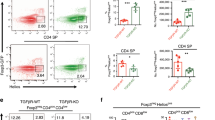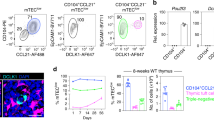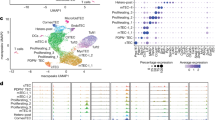Abstract
Medullary thymic epithelial cells (mTECs) are critical in establishing and maintaining the appropriate microenvironment for negative selection and maturation of immunocompetent T cells with a self-tolerant T cell antigen receptor repertoire. Cues that direct proliferation and maturation of mTECs are provided by members of the tumor necrosis factor (TNF) superfamily expressed on developing thymocytes. Here we demonstrate a negative role of the morphogen TGF-β in tempering these signals under physiological conditions, limiting both growth and function of the thymic medulla. Eliminating TGF-β signaling specifically in TECs or by pharmacological means increased the size of the mTEC compartment, enhanced negative selection and functional maturation of medullary thymocytes as well as the production of regulatory T cells, thus reducing the autoreactive potential of peripheral T cells.
This is a preview of subscription content, access via your institution
Access options
Subscribe to this journal
Receive 12 print issues and online access
$209.00 per year
only $17.42 per issue
Buy this article
- Purchase on Springer Link
- Instant access to full article PDF
Prices may be subject to local taxes which are calculated during checkout







Similar content being viewed by others
References
Anderson, G. & Takahama, Y. Thymic epithelial cells: working class heroes for T cell development and repertoire selection. Trends Immunol. 33, 256–263 (2012).
Rode, I. & Boehm, T. Regenerative capacity of adult cortical thymic epithelial cells. Proc. Natl. Acad. Sci. USA 109, 3463–3468 (2012).
Stritesky, G.L., Jameson, S.C. & Hogquist, K.A. Selection of self-reactive T cells in the thymus. Annu. Rev. Immunol. 30, 95–114 (2012).
Wirnsberger, G., Hinterberger, M. & Klein, L. Regulatory T-cell differentiation versus clonal deletion of autoreactivethymocytes. Immunol. Cell Biol. 89, 45–53 (2011).
van Ewijk, W. The thymus: “Interactive teaching during lymphopoiesis”. Immunol. Lett. 138, 7–8 (2011).
Kajiura, F. et al. NF-kappa B-inducing kinase establishes self-tolerance in a thymicstroma-dependent manner. J. Immunol. 172, 2067–2075 (2004).
Akiyama, T. et al. The tumor necrosis factor family receptors RANK and CD40 cooperatively establish the thymicmedullary microenvironment and self-tolerance. Immunity 29, 423–437 (2008).
Hikosaka, Y. et al. The cytokine RANKL produced by positively selected thymocytes fosters medullary thymic epithelial cells that express autoimmune regulator. Immunity 29, 438–450 (2008).
Irla, M. et al. Autoantigen-specific interactions with CD4(+) thymocytes control mature medullary thymic epithelial cell cellularity. Immunity 29, 451–463 (2008).
Nitta, T., Ohigashi, I., Nakagawa, Y. & Takahama, Y. Cytokine crosstalk for thymic medulla formation. Curr. Opin. Immunol. 23, 190–197 (2011).
Venanzi, E.S., Gray, D.H.D., Benoist, C. & Mathis, D. Lymphotoxin pathway and Aire influences on thymic medullary epithelial cells are unconnected. J. Immunol. 179, 5693–5700 (2007).
Derbinski, J. & Kyewski, B. How thymic antigen presenting cells sample the body's self-antigens. Curr. Opin. Immunol. 22, 592–600 (2010).
Zuklys, S. et al. Normal thymic architecture and negative selection are associated with Aire expression, the gene defective in the autoimmune-polyendocrinopathy-candidiasis-ectodermal dystrophy (APECED). J. Immunol. 165, 1976–1983 (2000).
Anderson, M.S. et al. Projection of an immunological self shadow within the thymus by the aire protein. Science 298, 1395–1401 (2002).
Anderson, M.S. & Su, M.A. Aire and T cell development. Curr. Opin. Immunol. 23, 198–206 (2011).
Massagué, J. TGFβ signalling in context. Nat. Rev. Mol. Cell Biol. 13, 616–630 (2012).
Takahama, Y., Letterio, J.J., Suzuki, H., Farr, A.G. & Singer, A. Early progression of thymocytes along the CD4/CD8 developmental pathway is regulated by a subset of thymic epithelial cells expressing transforming growth factor beta. J. Exp. Med. 179, 1495–1506 (1994).
Chen, W., Frank, M.E., Jin, W. & Wahl, S.M. TGF-beta released by apoptotic T cells contributes to an immunosuppressive milieu. Immunity 14, 715–725 (2001).
Li, M.O. & Flavell, R.A. TGF-beta: a master of all T cell trades. Cell 134, 392–404 (2008).
Hauri-Hohl, M.M. et al. TGF-beta signaling in thymic epithelial cells regulates thymic involution and postirradiation reconstitution. Blood 112, 626–634 (2008).
Zuklys, S. et al. Stabilized beta-catenin in thymic epithelial cells blocks thymus development and function. J. Immunol. 182, 2997–3007 (2009).
Bonnon, C. & Atanasoski, S. c-Ski in health and disease. Cell Tissue Res. 347, 51–64 (2012).
Rossi, S.W. et al. RANK signals from CD4+3- inducer cells regulate development of Aire-expressing epithelial cells in the thymic medulla. J. Exp. Med. 204, 1267–1272 (2007).
Meilin, A., Shoham, J., Schreiber, L. & Sharabi, Y. The role of thymocytes in regulating thymic epithelial cell growth and function. Scand. J. Immunol. 42, 185–190 (1995).
Trumpp, A. et al. c-Myc regulates mammalian body size by controlling cell number but not cell size. Nature 414, 768–773 (2001).
Gomis, R.R., Alarcón, C., Nadal, C., Van Poznak, C. & Massagué, J. C/EBPbeta at the core of the TGFbeta cytostatic response and its evasion in metastatic breast cancer cells. Cancer Cell 10, 203–214 (2006).
Kurobe, H. et al. CCR7-dependent cortex-to-medulla migration of positively selected thymocytes is essential for establishing central tolerance. Immunity 24, 165–177 (2006).
Nitta, T., Nitta, S., Lei, Y., Lipp, M. & Takahama, Y. CCR7-mediated migration of developing thymocytes to the medulla is essential for negative selection to tissue-restricted antigens. Proc. Natl. Acad. Sci. USA 106, 17129–17133 (2009).
Hsu, F.-C., Pajerowski, A.G., Nelson-Holte, M., Sundsbak, R. & Shapiro, V.S. NKAP is required for T cell maturation and acquisition of functional competency. J. Exp. Med. 208, 1291–1304 (2011).
Eck, S.C. et al. Developmental alterations in thymocyte sensitivity are actively regulated by MHC class II expression in the thymic medulla. J. Immunol. 176, 2229–2237 (2006).
Li, J. et al. Developmental pathway of CD4+CD8− medullary thymocytes during mouse ontogeny and its defect in Aire−/− mice. Proc. Natl. Acad. Sci. USA 104, 18175–18180 (2007).
Stephen, T.L., Tikhonova, A., Riberdy, J.M. & Laufer, T.M. The activation threshold of CD4+ T cells is defined by TCR/peptide-MHC class II interactions in the thymic medulla. J. Immunol. 183, 5554–5562 (2009).
Stephen, T.L., Wilson, B.S. & Laufer, T.M. Subcellular distribution of Lck during CD4 T-cell maturation in the thymic medulla regulates the T-cell activation threshold. Proc. Natl. Acad. Sci. USA 109, 7415–7420 (2012).
Leung, M.W.L., Shen, S. & Lafaille, J.J. TCR-dependent differentiation of thymic Foxp3+ cells is limited to small clonal sizes. J. Exp. Med. 206, 2121–2130 (2009).
Bautista, J.L. et al. Intraclonal competition limits the fate determination of regulatory T cells in the thymus. Nat. Immunol. 10, 610–617 (2009).
Tang, Q. et al. Cutting edge: CD28 controls peripheral homeostasis of CD4+CD25+ regulatory T cells. J. Immunol. 171, 3348–3352 (2003).
Aschenbrenner, K. et al. Selection of Foxp3+ regulatory T cells specific for self antigen expressed and presented by Aire+ medullary thymic epithelial cells. Nat. Immunol. 8, 351–358 (2007).
Burchill, M.A et al. Linked T cell receptor and cytokine signaling govern the development of the regulatory T cell repertoire. Immunity 28, 112–121 (2008).
Hinterberger, M., Wirnsberger, G. & Klein, L. B7/CD28 in central tolerance: costimulation promotes maturation of regulatory T cell precursors and prevents their clonal deletion. Front. Immunol. 2, 30 (2011).
Klein, L. & Jovanovic, K. Regulatory T cell lineage commitment in the thymus. Semin. Immunol. 23, 401–409 (2011).
Spence, P.J. & Green, E.A. Foxp3+ regulatory T cells promiscuously accept thymic signals critical for their development. Proc. Natl. Acad. Sci. USA 105, 973–978 (2008).
Coquet, J.M. et al. Epithelial and dendritic cells in the thymic medulla promote CD4+Foxp3+ regulatory T cell development via the CD27–CD70 pathway. J. Exp. Med. 210, 715–728 (2013).
Liston, A. et al. Differentiation of regulatory Foxp3+ T cells in the thymic cortex. Proc. Natl. Acad. Sci. USA 105, 11903–11908 (2008).
Kim, J.M., Rasmussen, J.P. & Rudensky, A.Y. Regulatory T cells prevent catastrophic autoimmunity throughout the lifespan of mice. Nat. Immunol. 8, 191–197 (2007).
Marks, B.R. et al. Thymic self-reactivity selects natural interleukin 17-producing T cells that can regulate peripheral inflammation. Nat. Immunol. 10, 1125–1132 (2009).
Kim, J.S., Smith-Garvin, J.E., Koretzky, G.A. & Jordan, M.S. The requirements for natural Th17 cell development are distinct from those of conventional Th17 cells. J. Exp. Med. 208, 2201–2207 (2011).
Villunger, A. et al. Negative selection of semimatureCD4(+)8(-)HSA+ thymocytes requires the BH3-only protein Bim but is independent of death receptor signaling. Proc. Natl. Acad. Sci. USA 101, 7052–7057 (2004).
von Boehmer, H. & Kisielow, P. Negative selection of the T-cell repertoire: where and when does it occur? Immunol. Rev. 209, 284–289 (2006).
Le Borgne, M. et al. The impact of negative selection on thymocyte migration in the medulla. Nat. Immunol. 10, 823–830 (2009).
Hirota, K. et al. T cell self-reactivity forms a cytokine milieu for spontaneous development of IL-17+ Th cells that cause autoimmune arthritis. J. Exp. Med. 204, 41–47 (2007).
Acknowledgements
We thank D.J. Campbell and J.A. Hamerman for helpful discussions about these data, and S. McCarty for help with preparation of the manuscript. This work was partially supported by grants from the Swiss National Science Foundation (M.H.-H. and G.A.H.).
Author information
Authors and Affiliations
Contributions
M.H.-H. performed all of the experiments in the manuscript, with help from S.Z.; M.H.-H., G.A.H. and S.F.Z. designed the experiments, analyzed data and contributed to writing the manuscript.
Corresponding author
Ethics declarations
Competing interests
The authors declare no competing financial interests.
Integrated supplementary information
Supplementary Figure 1 FN1-Cre–mediated deletion of TGFβRII does not affect the phenotype of cTECs.
(a) Assessment of FN1-Cre-mediated genomic deletion of the floxed sequence in total TEC sorted from E14 thymic stroma, derived from either TβRIIlox/lox/FN1-Cre (denoted ‘Crepos’) or TβRIIlox/lox (‘Creneg’) embryos. (b) Gating strategy to identify TEC subpopulations from total thymic tissue, digested with Collagenase and DNAse. (c) Characterization of the cTEC compartment in 4-week-old TβRIIlox/lox/FN1-Cre mice or littermate controls for the expression of MHCII, β5t and DEC205.
Supplementary Figure 2 Altered expression of TRA with preserved thymic architecture in thymi with altered TGF-β signaling.
(a) Thymic section derived from 4 week old TβRIIlox/lox/FN1Cre or littermates stained for H&E, cytokeratin-5, cytokeratin-14 or UEA1 respectively. (b) Expression of indicated TRAs within total thymus of TβRIIlox/lox/FN1Cre (white bars, N=4), relative to expression found in littermate controls (black bars, N=5). (c) Absolute numbers of thymocytes and (d) relative distribution of thymocyte subpopulations in 6-8 week-old C57Bl/6 mice treated daily with SB431542 (white bars, N=8) or vehicle only (black bars, N=8) for 6 consecutive days, analysed on day 12 after the first injection. For statistical analysis, a two-tailed, unpaired t-test was used; NS denotes not statistically different whereas asterisks indicate a p-value of ≤0.05 (*),≤0.01 (**) or ≤0.001(***).
Supplementary Figure 3 TGF-β limits RANKL-induced mTEC differentiation.
Lymphocyte-depleted fetal thymi were cultured in the presence of the indicated stimuli for 5 days and assessed for the up-regulation of MHCII and CD80 within the mTEC compartment. Note the reduction in MHCIIhigh and CD80pos cells in the presence of RANKL/TGFβ vs RANKL alone, and a corresponding increase in the MHCIIlow population.
Supplementary Figure 4 Reduced thymic cellularity but normal thymocyte development and maturation in mice with c-myc–deficient TECs.
(a) Thymocyte cellularity and (b) relative distribution of thymocyte subpopulations with respect to CD4 and CD8 (upper panel) or CD69 and TCRβ (lower panel) expression in 4 week old c-myclox/lox/FN1-Cre mice (white bar) and littermate controls (black bar).
Supplementary Figure 5 Thymocyte maturation, export and functional changes of peripheral T cells in Tgfbr2fl/flFN1-Cre mice.
(a) Absolute numbers of DP and DN thymocytes in 4 week-old TβRIIlox/lox/FN1-Cre mice (white bars, N=5) and controls (black bars, N=5). (b) Flow cytometry profiles (left panel) of thymocytes for CD69 and TCR□ expression derived from 4-week-old mice and (right panel) statistical summary of the indicated subpopulations (R3: TCRintCD69pos, R4: TCRhighCD69pos, R5: TCRhighCD69neg). White bars denote TβRIIlox/lox/FN1-Cre mice (N=5), black bars littermate controls (N=5). (c) Absolute numbers of immature (i.e. CD24highCD62Llow) CD4 or CD8 TCRhigh SP thymocytes from TβRIIlox/lox/FN1-Cre mice (white bars, N=5) and controls (black bars, N=7). (d) GFP expression in immature (upper panel) and mature (lower panel) TCRhigh SP4 thymocytes derived from either controls (shaded histogram) or TβRIIlox/lox/FN1-Cre mice (open histogram), which were lethally irradiated and reconstituted with T-cell-depleted bone marrow cells from congenically marked mice that express GFP under the control of the Rag2-promoter (representative of 3 (TβRIIlox/lox/FN1-Cre mice) and 4 (littermate controls) mice from two independent experiments are shown). (e) Percentage of splenic CD4 or CD8 T cells in TβRIIlox/lox/FN1-Cre mice and littermate controls at the age of 3 days (left panel) and 6 days (right panel). White bars denote TβRIIlox/lox/FN1-Cre mice, black bars littermate controls. Two individual litters per time point with a minimum of total 3 mice per genotype are shown. (f) Absolute numbers of FITCpos recent thymic emigrants in peripheral lymphoid organs recovered 24 hours after intrathymic injection of 10μl FITC. White bars denote TβRIIlox/lox/FN1-Cre mice (N=16), black bars littermate controls (N=14). (g) Frequency of CD69pos cells within sorted peripheral naïve CD4 T cells from TβRIIlox/lox/FN1-Cre mice (white bars) or littermate controls (black bars) 20 hours after stimulation with the indicated stimuli. (h) Proliferation assessed by CFSE-dilution in sorted peripheral naïve CD4 T cells derived from TβRIIlox/loxFN1-Cre mice (upper histogram) and littermate controls (lower histogram) after a 4-day stimulation culture with 1μl/ml α-CD3 and 5μg/ml α-CD28. For statistical analysis, a two-tailed, unpaired t-test was used; NS denotes not statistically different whereas asterisks indicate a p-value of ≤0.05 (*), ≤0.01 (**) or ≤0.001(***).
Supplementary Figure 6 Reduced frequency of natural TH17 cells in thymus and spleen of Tgfbr2fl/flFN1-Cre mice.
Flow cytometry profiles (left panel) and corresponding bar graphs and statistics (right panel) of CD4SP TCRhigh thymocytes (a) and splenic CD4pos T cells (b) derived from 4-week-old mice after a 4 hour culture with PMA, Ionomycin and Brefeledin A. Data shown from 2 experiments with a total of 9 mice (asterisks indicate a p-value of ≤0.05 (*) or ≤0.01 (**)). (a, b) White bars denote TβRIIlox/lox/FN1-Cre mice, black bars littermate controls.
Supplementary information
Supplementary Text and Figures
Supplementary Figures 1–6 (PDF 5335 kb)
Rights and permissions
About this article
Cite this article
Hauri-Hohl, M., Zuklys, S., Holländer, G. et al. A regulatory role for TGF-β signaling in the establishment and function of the thymic medulla. Nat Immunol 15, 554–561 (2014). https://doi.org/10.1038/ni.2869
Received:
Accepted:
Published:
Issue Date:
DOI: https://doi.org/10.1038/ni.2869
This article is cited by
-
Depletion of Ift88 in thymic epithelial cells affects thymic synapse and T-cell differentiation in aged mice
Anatomical Science International (2022)
-
CD147 deficiency in T cells prevents thymic involution by inhibiting the EMT process in TECs in the presence of TGFβ
Cellular & Molecular Immunology (2021)
-
Leaving no one behind: tracing every human thymocyte by single-cell RNA-sequencing
Seminars in Immunopathology (2021)
-
Myc controls a distinct transcriptional program in fetal thymic epithelial cells that determines thymus growth
Nature Communications (2019)
-
RelB intrinsically regulates the development and function of medullary thymic epithelial cells
Science China Life Sciences (2018)



